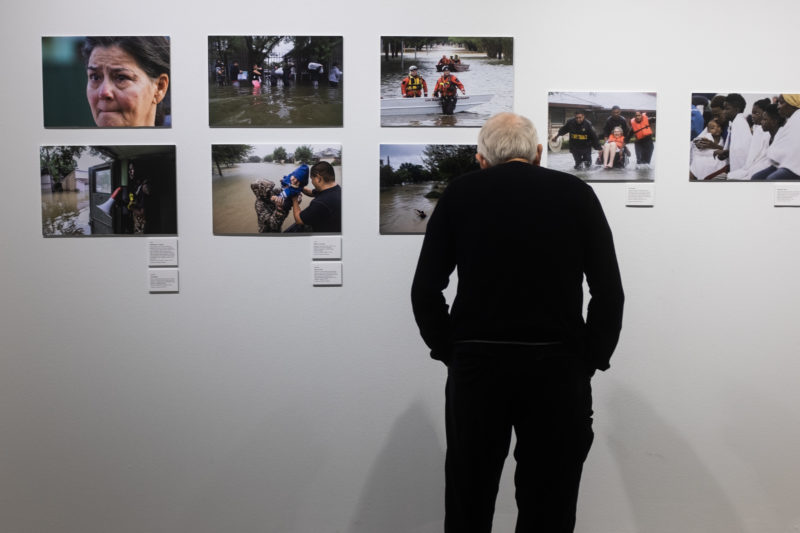Long After Water Recedes, Stories from Hurricane Harvey Remain in Online Museum
By Abigail Rosenthal
Photography By Michael Minasi
Reporting Texas

A visitor browses through photos shot by Houston Chronicle photographers during FotoFest’s “Seeing Harvey” exhibit on Saturday, Oct. 27, 2018, at the Silver Street Studios in Houston, Texas. The Houston Flood Museum helped curate images from the community for the exhibit. Michael Minasi/Reporting Texas
As Lacy Johnson discovered during Hurricane Harvey, disasters look much different from the inside than the outside, especially once the immediate danger has passed.
While her husband was out helping their flooded neighbors in their West Houston neighborhood September 2017, Johnson stayed behind, activated her Facebook page and began to write, chronicling what was still happening days after the storm. The suffering she saw was far from over, but it seemed that people outside of it had moved on.
Johnson, a writer and assistant professor of English at Rice University, wanted others outside of Houston to see what was happening, but to also process what was happening herself. That desire ultimately turned into the Houston Flood Museum, an online archive launched Aug. 28 of audio recordings, essays, pictures and poems from the days during and after the flood.
Hurricane Harvey made landfall in Rockport on Aug. 25. It left the Houston region six days later after dumping 19 trillion gallons of water on Texas, turning freeways into rivers and neighborhoods into lakes, costing an estimated $125 billion. Many Houston residents are still repairing homes and healing.
Johnson’s home ultimately didn’t flood, but her posts garnered thousands of shares and comments. Soon after, Houston Endowment Program Officer Bao-Long Chu approached her about spearheading a story collecting project. The flood museum was just a counter offer, according to Johnson.
“It definitely aligned with … the opportunity we realized would exist after an event like Harvey — a space in which stories are shared with one another and community members could connect with one another,” Chu said.
The Houston Flood Museum officially began collecting stories from the public on Aug. 28. The website now hosts audio from Houston Public Media; images of the damage, recovery and rescues; and stories from the community told through poems, video, essays and audio. The collection process is far from finished — every page offers a link to the Google Form where one can submit a story. Submissions have been slow, but Johnson said there’s a good reason.
“One issue is that the people who have been most affected by (Harvey) are not done being affected by it,” Johnson said. “Folks like that don’t have time to sit down and tell their story.”
Through the Houston Flood Museum, Johnson is hoping to put pressure on the idea that flooding is an inevitable and unchangeable part of living in Houston.
“The ways that we experience it could be made more just than they are,” Johnson said. “There’s a lot of wealth and income inequality and socioeconomic difference in terms of how people experience the flooding that we get really every time we have a good rain.”
The Houston Flood Museum isn’t meant to recreate Harvey for those who didn’t experience the flooding firsthand — it’s not “disaster tourism” and is avoiding creating an official narrative in lieu of telling all types of stories. But is also meant to help those who experienced the storm think about the future.
“I think it’s meant first and foremost for Houston residents, for people who live in Houston and experienced Hurricane Harvey most recently to understand what we have each experienced and … to foster a kind of collective understanding,” Johnson said.
As technology has advanced, virtual museums have become more common, said Elizabeth Merritt of the Center for the Future of Museums at the American Alliance of Museums in Arlington, Virginia. Some, like the Houston Flood Museum, have no intention of ever becoming a physical site.
“There are cool things you can do with digital that you can’t do with physical … it’s a different way of interacting,” Merritt said in an email. “Once you have all this material in the form of digital data, there are new ways to play with it and explore it.”
As a website, the Houston Flood Museum allows for the narratives of Houston to remain center stage, first and foremost for Houston, and secondarily for others. Visitors are unencumbered by visiting hours, location or space — all one needs is a willingness to engage and spend time with the stories from the storm.
“If you give your attention to the story of another person, you are generous enough with your imagination to be able to enter that story and understand what it might have been like for them from that perspective,” Johnson said. “Not what it would be like for you, but what it was like for another person.”